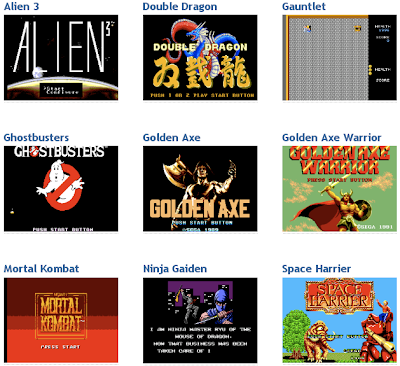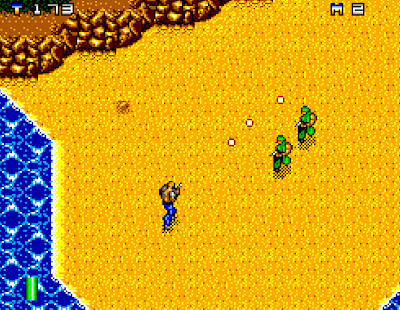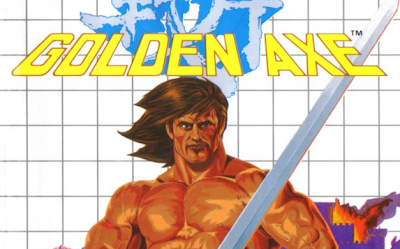The second, and possibly the best-known title in a serious of infamously difficult platform shoot-em-up games by Capcom, with a comically medieval aesthetic. Considering that the NES received a conversion of the original, 8-bit Ghosts and Goblins, it is curious that Sega chose for their own 8-bit system its sequel: a game programmed on the same high-powered hardware as MERCS and Strider, and patently not one that the humble SMS could hope to convert 100% accurately. Was this ambition worth it?
 Graphics
Graphics:
Ghouls ‘n Ghosts was converted to many home systems, and even in the 16-bit conversions, such as those for the Genesis and Amiga, the lush graphics of the arcade – especially the detailed backdrops – were the most obvious casualty. That applies even more for the 8-bit conversions, and of these the Master System is easily the best-looking.
That said, there are negative points: limitations of memory resources show in the use of some unmasked, black-outlined sprites; some glaringly blocky backdrop design (especially in the first two levels, though it improves considerably from level 3 onwards); and stiff animation even in comparison to the C64 version. Some enemies, such as the “mud knights” and “goblin hands” (it’s a weird world out there …), don’t animate at all in this version, and nor do some of the bosses. The sprite limits are pushed too far on occasion, leading to a good deal of flicker and even to disappearing sprites. Some complex, multi-sprite enemies are absent altogether, although this is a blessing in disguise, as it makes the relevant sections of the game (such as level 1’s hill, riddled with random tentacle attacks in the arcade) a good deal fairer. Finally, the presentation (including the end sequence) is on the minimal side.
On the plus side, however, there is a good deal to praise: the sprites are large, colourful, detailed, and all very recognisable from their arcade originals. All but a few of the enemies have survived the conversion. Even the multi-sprite bone dragons from level 5 have made it across, albeit a little shortened to keep them within the sprite limits.
As for the backgrounds, after a somewhat disappointing beginning (especially a very poor rainstorm effect in level 1, and flat windmills in level 2 that looked better even on the Amstrad CPC) the level graphics start to improve dramatically, with impressive renditions of the burning, earthquake-stricken town; the “gargoyle tongue bridges” level (I said it was weird); and levels 4 and 5 (crystal caves and Lucifer’s castle), which look almost 16-bit-quality. Best of all, however, are the huge bosses, which are depicted using the same trick as in MERCS: to draw them as movable backdrops rather than attempting to expand or join together sprites. Whilst this limits their mobility and animation, and in consequence necessitates changes in their original attack patterns, it allows them to be huge and detailed in high-resolution, even to the point of looking almost arcade-quality.
This is also the only 8-bit version of the game to include the final boss, Lucifer … known here as Loki, perhaps to avert criticism that the game had Satanic themes (though I’m not sure that hurling fireballs in Satan’s face counts as a pro-Satanic activity). As he was a very static boss even on the arcade, he comes across very impressively on the SMS; better even than his Amiga depiction. He is however, a laughably easy kill, but that is a gameplay issue.
90%
 Sound
Sound:
The first version of this game I owned was on the C64, which had a recomposed, prog-rock influenced soundtrack by Tim Follin, generally held to be one of the classic video game soundtracks. The SMS version has the standard arcade tunes, which were, I must admit, rather disappointing on first hearing: alright enough, but not as atmospheric as the C64 and Amiga remixes.
Compared to the actual arcade soundtrack, however, the Master System does manage to hold its own. The medieval-style ditties are well suited to the limited instrumentation of the Z80 chip, and actively help to preserve the atmosphere of the game. Even the sound effects, rarely a feature of much note on the SMS, show some creative flair here: the guillotines in level 1 descend with a metallic “clang”, level 2’s rock turtles bounce crashingly along, the earthquake rumbles as the screen shakes, and bats come swooping down with a very cartoon-like descending note effect. Unfortunately, every so often you may hear a sound effect cause one of the music channels to cut out. However, in all fairness the C64 version could only run either music or sound effects – not both simultaneously – so in spite of the renowned C64 soundtrack, the SMS still has the edge even in this department (which is hardly its strongest, as a rule).
85%Gameplay:
Basically the same running, shooting, ducking, and ladder-climbing action as in the arcade version, but with significant alternations, some of which are due to the limitations of the SMS and the rest of which are deliberate changes. In most cases, these work to the game’s advantage, and actually make it my favourite version.
As in MERCS – another Capcom 16-bit conversion – the sprite and memory limits mean that attack waves have been simplified. Enemy numbers are reduced, some enemy types are missing, and some attack patterns that were random in the arcade are consistent in this version, making it possible to memorise one’s way through levels and reducing the reaction-based nature of the gameplay. Although this makes for a less adrenal experience, it is a lot less frustrating than the arcade, in which even level 1 required split-second responses to randomly spawning enemies.
Similarly, the boss attacks are simplified, and far easier to deal with. A notable exception is the level 4 boss, which is extremely impressively rendered (bearing in mind that its arcade attack pattern was also very simple). However, all of the bosses can be very easily dealt with by using magic.
Magic spells are selectable from a menu in this version, rather than only one being available at a time depending on which weapon you are carrying. More spells are gained by choosing better “helmets” from the upgrade screen (which is accessed through certain treasure chests, and is the main deliberate alteration to this version). Although your spell-casting power is limited (albeit rechargeable), the powers it gives you – lightning bolts, fireballs, temporarily doubling your firepower, temporary invincibility, smart bombs, and healing – make the game significantly easier in its later stages, and make the final boss in particular ludicrously easy. This particular aspect of gameplay could have been better thought out, although on the whole the upgrade system works to make the game more user-friendly than its insanely difficult arcade counterpart.
Other upgrades include stronger armour which can stand more hits, although enough strikes will still leave your knight in only his underpants (almost the trademark of this series); and faster boots which must be collected before the armour, as heavier armour without matching boots will seriously impede your jumping ability. Also, the weapons system has been changed from the arcade, in which the six weapons were randomly acquired bonuses, although three of them – the axe, torch, and sword – were next to useless and could ruin the whole game if you were luckless enough to collect them. The useless weapons have been altered and / or removed from this version, and increasingly powerful weapons are collected in sequential order at the upgrade points, just like the armour. The different stages are javelin (standard, adequate weapon), dagger (rapid fire), axe (stronger), discus (strong, and can follow the terrain), and fireball (strong and very rapid fire). The final weapon of all, required for the last boss, is the psycho cannon, which is a full-range weapon in this version, unlike its short-range arcade equivalent. Although it was somewhat of a deliberate challenge in the arcade, forcing the player to accept a short-range weapon in order to win, it is certainly a lot less frustrating in this version to only suffer a small downgrade: the SMS psycho cannon fires less rapidly than the fireball weapon, although that does at least mean it causes less sprite flicker.
Finally, it ought to be noted that although the infinite continue and upgrade options make this game winnable without actual cheating, you are still likely to expend many lives (and continues) in the process. It essentially offers the player the choice of how long they wish to go on, which is no different from the arcade (except for the small advantage that you don’t have to put more money in your Master System).
90%Overall:
Looking back, I can’t help but wonder if Sega were being deliberately cheeky in upstaging the NES conversion of Ghosts and Goblins with a surprisingly impressive version of its 16-bit sequel on their own 8-bit machine. In fact, most home versions of this game, with the exception of the slightly disappointing Amiga version and the Amstrad version (which suffers from dodgy scrolling), manage to retain much of the original game’s surreal charm (it helps that it has a basically simple game style, albeit complemented with cutting edge – for the time – 16-bit graphics). The Master System version has additional advantages, being the only version to specifically tailor its gameplay with user-friendly features and make it less frustrating than the arcade. Granted, some of these changes actually make the game too easy in places, but it is still a respectable challenge if one limits one’s continue-plays (but if you want to play through to the end, the option is there). Furthermore, it is an excellent showcase of the system’s graphical power, even outshining the Amiga version in places and spectacularly upstaging NES Ghosts and Goblins.
This game is a superb example of what the Master System could achieve in the hands of dedicated programmers who played to its strengths, worked creatively within its limitations, and did not attempt to take their lead from conversions on other systems. For the ignominious results of that sort of approach, see Strider, SMS version of … then play Ghouls ‘n Ghosts again to take away the taste.
90% The Master System does colour and detail very well, but its major stumbling block is processing speed, which meant that even technically inferior 8-bit systems such as the C64 and NES had the edge over it in driving games. Its best efforts are the respectable (but very simplified) version of "Out Run" and the surprisingly impressive 8-bit version of "Road Rash", which both manage to squeeze some interesting track layouts and fair speed out of the hardware. By and large, however, driving games on the SMS tend to be very compromised affairs. "World Grand Prix", "Chase HQ", and "Hang On" all have flat, rather featureless tracks with limited scenery and no topography, while "Out Run Europa" has plenty of scenery but a poor frame rate and an unrealistic control system, with the car not being centred on the screen, so all sense of a driving simulator is lost.
The Master System does colour and detail very well, but its major stumbling block is processing speed, which meant that even technically inferior 8-bit systems such as the C64 and NES had the edge over it in driving games. Its best efforts are the respectable (but very simplified) version of "Out Run" and the surprisingly impressive 8-bit version of "Road Rash", which both manage to squeeze some interesting track layouts and fair speed out of the hardware. By and large, however, driving games on the SMS tend to be very compromised affairs. "World Grand Prix", "Chase HQ", and "Hang On" all have flat, rather featureless tracks with limited scenery and no topography, while "Out Run Europa" has plenty of scenery but a poor frame rate and an unrealistic control system, with the car not being centred on the screen, so all sense of a driving simulator is lost. Sound is nothing to write home about at all. There is a typical engine hum and undistinguished sound effects during the race, and music on the presentation screens, but nothing to rival the excellent soundtracks for contemporary SMS racers such as "Out Run Europa" and "Road Rash", or, come to that, the music tracks for "Out Run".
Sound is nothing to write home about at all. There is a typical engine hum and undistinguished sound effects during the race, and music on the presentation screens, but nothing to rival the excellent soundtracks for contemporary SMS racers such as "Out Run Europa" and "Road Rash", or, come to that, the music tracks for "Out Run".













